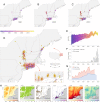Phylogeographic reconstruction of the emergence and spread of Powassan virus in the northeastern United States
- PMID: 37040418
- PMCID: PMC10120011
- DOI: 10.1073/pnas.2218012120
Phylogeographic reconstruction of the emergence and spread of Powassan virus in the northeastern United States
Abstract
Powassan virus is an emerging tick-borne virus of concern for public health, but very little is known about its transmission patterns and ecology. Here, we expanded the genomic dataset by sequencing 279 Powassan viruses isolated from Ixodes scapularis ticks from the northeastern United States. Our phylogeographic reconstructions revealed that Powassan virus lineage II was likely introduced or emerged from a relict population in the Northeast between 1940 and 1975. Sequences strongly clustered by sampling location, suggesting a highly focal geographical distribution. Our analyses further indicated that Powassan virus lineage II emerged in the northeastern United States mostly following a south-to-north pattern, with a weighted lineage dispersal velocity of ~3 km/y. Since the emergence in the Northeast, we found an overall increase in the effective population size of Powassan virus lineage II, but with growth stagnating during recent years. The cascading effect of population expansion of white-tailed deer and I. scapularis populations likely facilitated the emergence of Powassan virus in the northeastern United States.
Keywords: Ixodes scapularis; deer tick virus; genomics; tick-borne flavivirus; ticks.
Conflict of interest statement
N.D.G. is a consultant for Tempus Labs and the National Basketball Association for work related to COVID-19.
Figures




Similar articles
-
Evidence of Powassan/deer tick virus in adult black-legged ticks (Ixodes scapularis) recovered from hunter-harvested white-tailed deer (Odocoileus virginianus) in Pennsylvania: A public health perspective.Zoonoses Public Health. 2018 Aug;65(5):589-594. doi: 10.1111/zph.12476. Epub 2018 Apr 29. Zoonoses Public Health. 2018. PMID: 29707917
-
Powassan Viruses Spread Cell to Cell during Direct Isolation from Ixodes Ticks and Persistently Infect Human Brain Endothelial Cells and Pericytes.J Virol. 2022 Jan 12;96(1):e0168221. doi: 10.1128/JVI.01682-21. Epub 2021 Oct 13. J Virol. 2022. PMID: 34643436 Free PMC article.
-
Detection of Borrelia miyamotoi and Powassan Virus Lineage II (Deer Tick Virus) from Odocoileus virginianus Harvested Ixodes scapularis in Oklahoma.Vector Borne Zoonotic Dis. 2022 Apr;22(4):209-216. doi: 10.1089/vbz.2021.0057. Vector Borne Zoonotic Dis. 2022. PMID: 35446170
-
Powassan Virus: An Emerging Arbovirus of Public Health Concern in North America.Vector Borne Zoonotic Dis. 2017 Jul;17(7):453-462. doi: 10.1089/vbz.2017.2110. Epub 2017 May 12. Vector Borne Zoonotic Dis. 2017. PMID: 28498740 Free PMC article. Review.
-
The known unknowns of Powassan virus ecology.J Med Entomol. 2023 Nov 14;60(6):1142-1148. doi: 10.1093/jme/tjad095. J Med Entomol. 2023. PMID: 37862099 Free PMC article. Review.
Cited by
-
Comparative Pathogenesis of Two Lineages of Powassan Virus Reveals Distinct Clinical Outcome, Neuropathology, and Inflammation.Viruses. 2024 May 22;16(6):820. doi: 10.3390/v16060820. Viruses. 2024. PMID: 38932113 Free PMC article.
-
Functional Roles and Host Interactions of Orthoflavivirus Non-Structural Proteins During Replication.Pathogens. 2025 Feb 12;14(2):184. doi: 10.3390/pathogens14020184. Pathogens. 2025. PMID: 40005559 Free PMC article. Review.
-
Inferring Evolutionary Timescale of Omsk Hemorrhagic Fever Virus.Viruses. 2023 Jul 19;15(7):1576. doi: 10.3390/v15071576. Viruses. 2023. PMID: 37515262 Free PMC article.
-
Analysis of Powassan Virus Genome Sequences from Human Cases Reveals Substantial Genetic Diversity with Implications for Molecular Assay Development.Viruses. 2024 Oct 23;16(11):1653. doi: 10.3390/v16111653. Viruses. 2024. PMID: 39599768 Free PMC article.
-
Virus Isolation from Field-Collected Ticks: In Vivo.Methods Mol Biol. 2025;2936:17-24. doi: 10.1007/978-1-0716-4587-1_3. Methods Mol Biol. 2025. PMID: 40512305
References
-
- Centers for Disease Control and Prevention, National Center for Emerging and Zoonotic Infectious Diseases (NCEZID), Division of Vector-Borne Diseases (DVBD), Tickborne disease surveillance data summary (2019). https://www.cdc.gov/ticks/data-summary/index.html. Accessed 16 May 2019.
-
- ArboNET, Arboviral Diseases Branch, Centers for Disease Control and Prevention, Powassan virus neuroinvasive disease cases reported by year, 2008–2017 (2018). https://www.cdc.gov/powassan/statistics.html. Accessed 22 April 2019.
-
- Ebel G. D., Update on Powassan virus: Emergence of a North American tick-borne flavivirus. Annu. Rev. Entomol. 55, 95–110 (2010). - PubMed
Publication types
MeSH terms
Supplementary concepts
Grants and funding
LinkOut - more resources
Full Text Sources

